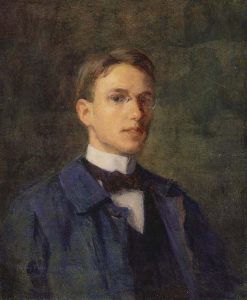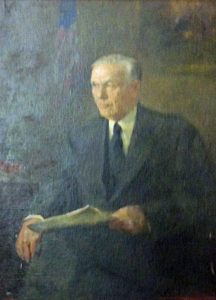 Augustus Vincent Tack (1870 – 1949) was born in Pittsburgh and moved to New York City at the age of 13. By 19 his artwork had attracted the eye of painter John LeFarge, who mentored him and introduced him to other artists, such as Claude Monet. Later, he became very close to Duncan Phillips, whose patriotism and support of American soldiers would lead the two to become involved in the Allied War Salon of 1918. This exhibition was “organized for the purpose of developing the field of art in connection with the war, where the services of artists, architects, sculptors, and those practicing the allied arts are employed.” Duncan Phillips would become his patron, and forty of Tack’s paintings would be part of the Phillips Collection, that was opened to the public in 1921 and was located in D.C.’s Dupont Circle.
Augustus Vincent Tack (1870 – 1949) was born in Pittsburgh and moved to New York City at the age of 13. By 19 his artwork had attracted the eye of painter John LeFarge, who mentored him and introduced him to other artists, such as Claude Monet. Later, he became very close to Duncan Phillips, whose patriotism and support of American soldiers would lead the two to become involved in the Allied War Salon of 1918. This exhibition was “organized for the purpose of developing the field of art in connection with the war, where the services of artists, architects, sculptors, and those practicing the allied arts are employed.” Duncan Phillips would become his patron, and forty of Tack’s paintings would be part of the Phillips Collection, that was opened to the public in 1921 and was located in D.C.’s Dupont Circle.
Tack taught at Yale and the Art Students League and had studios in New York City and Washington, D.C. He was considered an early modern artist because of his large-format canvases of mythical spaces and visionary landscapes, often meant to evoke themes of spirituality and creation. He bridged the gap between modern and abstract art, influencing future color-field painters such as Morris Louis of the Washington Color School and the early abstract artist Clyfford Still. Tack was often commissioned to paint traditional murals in Catholic churches or portraits of political and military figures. Among the notable figures who sat for Tack were Helen Keller, Elihu Root, General John J. Pershing, General Dwight D. Eisenhower, Harry S. Truman, Admiral Chester W. Nimitz and General George C. Marshall.
 Two portraits of General George C. Marshall were acquired from the Phillips Collection, (who inherited the paintings from Tack’s estate) by the Marshall Foundation in 1992. After a fundraising effort, Mrs. Susie Vaughan Neikirk donated the funds to purchase the larger 36” x 50” portrait and dedicate it to the memory of her husband, Joseph D. Neikirk VMI ’32 and Executive Vice-President of the VMI Foundation from 1954-1978. Additional donations secured the purchase of the smaller 20” x 24” academic study portrait. At the time of the purchase, it was confirmed that General Marshall did sit for the portrait. He had five appointments with Tack in 1947 and two in 1948. This makes the painting even more valuable to the museum because, as former Foundation President R.F. Marryott wrote: “we know that the General thought that posing for most painters was a waste of time.”
Two portraits of General George C. Marshall were acquired from the Phillips Collection, (who inherited the paintings from Tack’s estate) by the Marshall Foundation in 1992. After a fundraising effort, Mrs. Susie Vaughan Neikirk donated the funds to purchase the larger 36” x 50” portrait and dedicate it to the memory of her husband, Joseph D. Neikirk VMI ’32 and Executive Vice-President of the VMI Foundation from 1954-1978. Additional donations secured the purchase of the smaller 20” x 24” academic study portrait. At the time of the purchase, it was confirmed that General Marshall did sit for the portrait. He had five appointments with Tack in 1947 and two in 1948. This makes the painting even more valuable to the museum because, as former Foundation President R.F. Marryott wrote: “we know that the General thought that posing for most painters was a waste of time.”
The larger portrait, located in the lobby of the museum, depicts Marshall in civilian clothing as Secretary of State in 1947. It is a contemplative pose for Marshall, and as a fine example of Tack’s style, there is an unseen source of light, giving Marshall a divine and thoughtful presence. Upon viewing the painting for the first time, Marshall portraitist Christine Pogue remarked she “particularly liked the eyes” and “impressionistic hands.”
Stop by the museum to take another look at this fine work of art.
